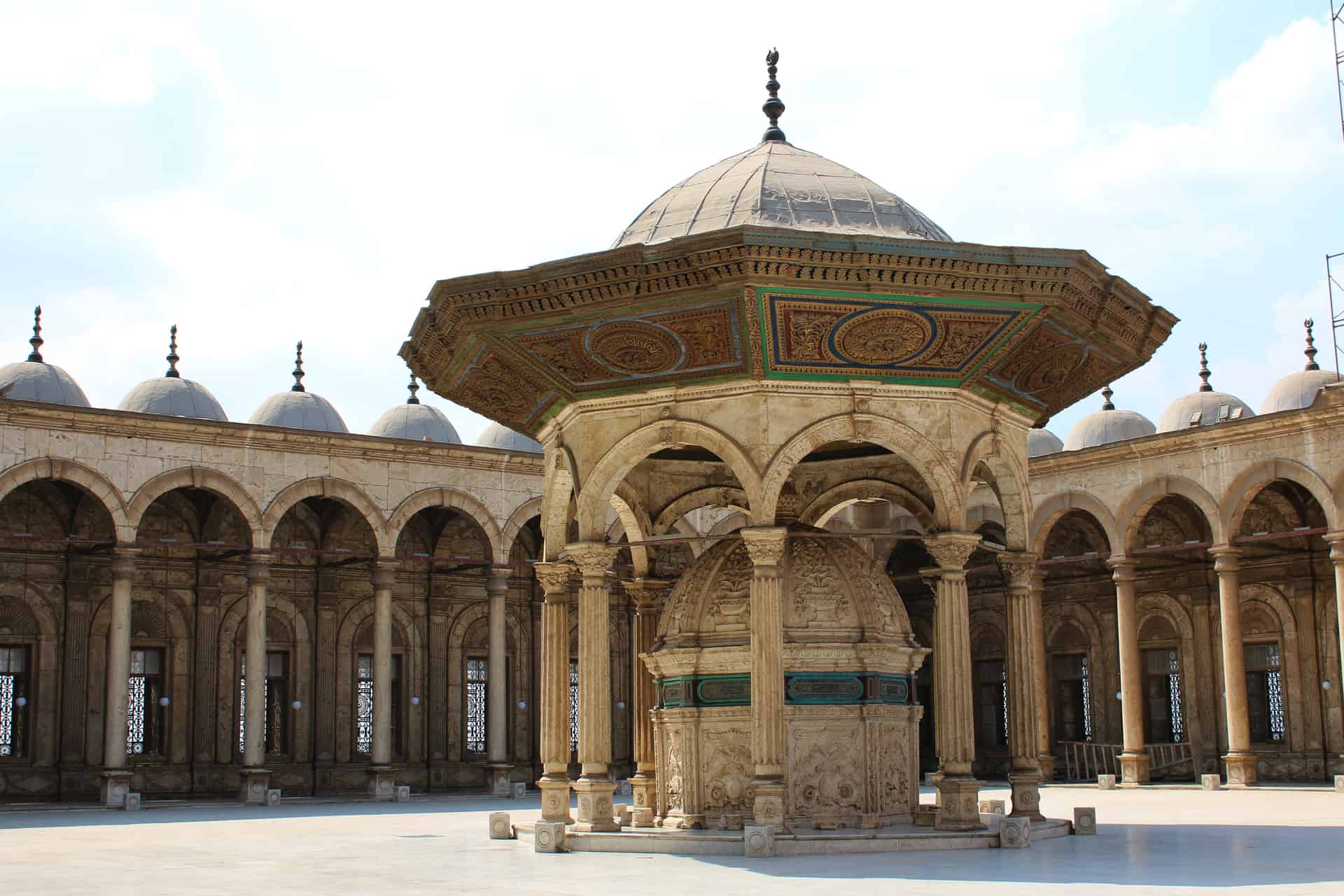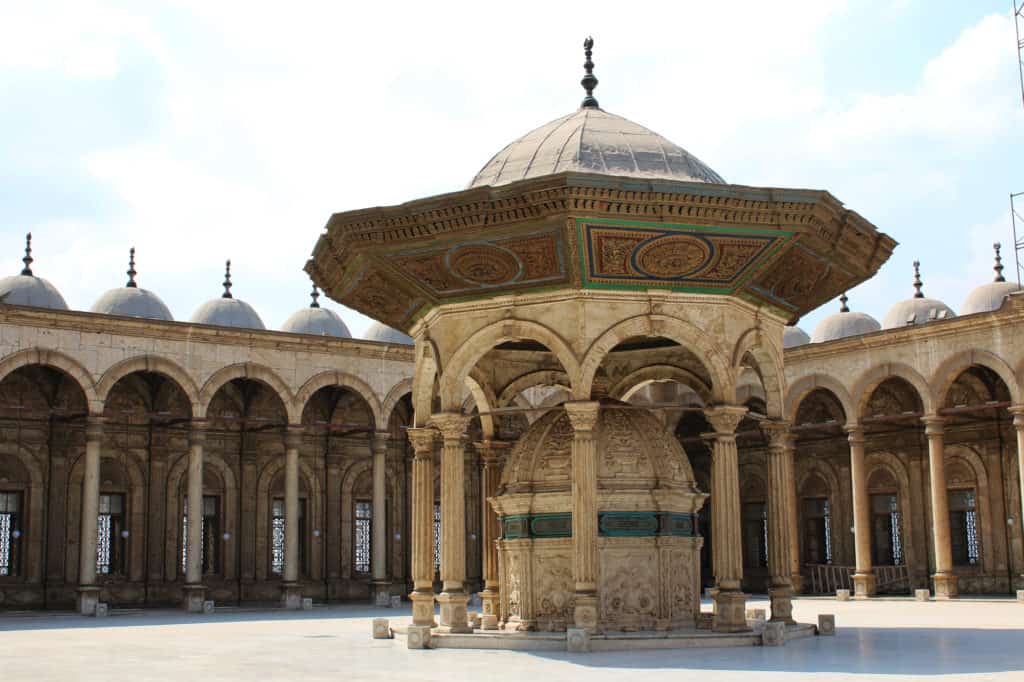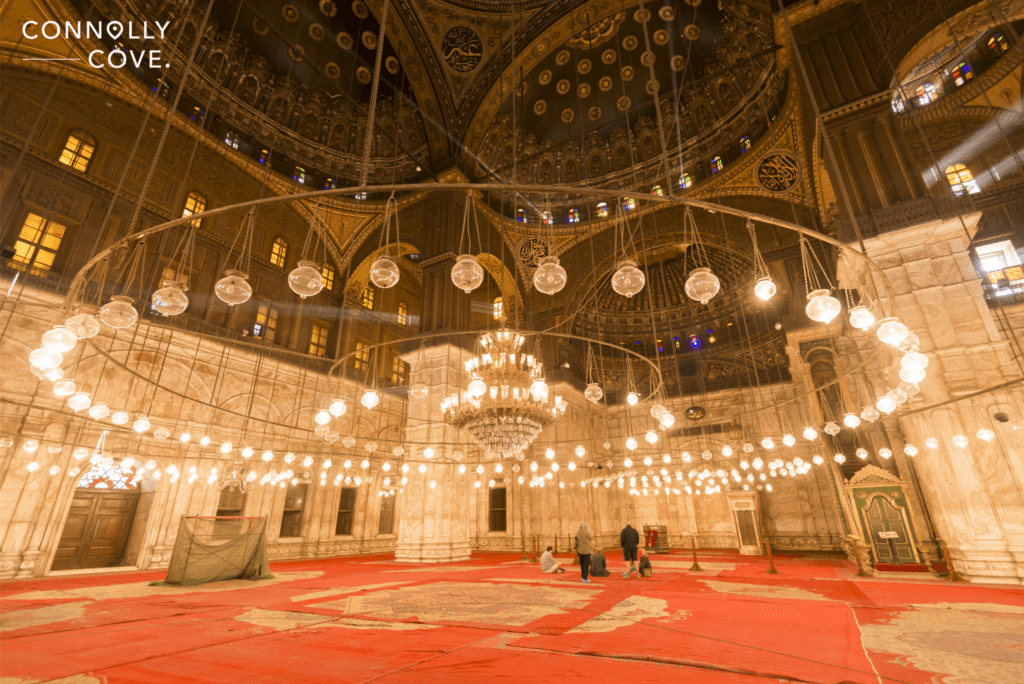Muhammad Ali Mosque, Cairo, Egypt

Updated On: March 28, 2024 by Dina Essawy
The Muhammad Ali Mosque can be found in Cairo, Egypt’s capital, a tapestry rich in a trove of antiquities and historical sites, with a mesh of the past and the present coming to life. Its history starts three centuries before the Fatimids had founded the town of al-Qahira, with the Arab conquest of Egypt in 640 CE.
The city was born over about six centuries and evolved over different phases: it was established by the Arab conquerors as Fustat in 642 CE, and it was the first capital of Egypt under Muslim rule. Later, in 969 CE, the Fatimid conquerors founded Cairo (al-Qahira in Arabic), and the Salah el-Din Citadel was established in 1176 CE.
Situated on the summit of the Salah el-Din Citadel is a Cairo landmark marked by its size, dominating location and unparalleled contribution to the city skyline … the Great Mosque of Muhammad Ali Pasha—AKA the Alabaster Mosque—which is one of the largest mosques built in the first half of the 19th century. It is one of the landmarks of Cairo that should be on your tour for its spectacular architecture. It is known as the Alabaster Mosque since its walls are made of alabaster, a beautiful white marble-like gypsum.
Overlooking the city, the Mosque was built in a classical Ottoman imperial architectural form, breaking away from the Mamluk structural and decorative style. Not only did it follow the Ottoman style, but its architecture included several European elements that were popular in Istanbul in the 18th century. This mesh of styles came to be known as Ottoman Baroque.
Muhammad Ali Pasha
Muhammad Ali was born in 1769 in Kavala, Macedonia, Ottoman Empire (now in Greece), and was probably of Albanian origins. He was born into a family where the father, Ibrahim Agha, was the commander of a small provincial military force that the governor of Kavala maintained. He died early, leaving Muhammad Ali a young boy to be brought up by the governor.
In the troops sent to Egypt to free the country from Napoleon‘s three-year French occupation (1798–1801), Muhammad Ali was a soldier who fought in the battle of Abou Qir in 1799. He was promoted later, in 1801, to become the commander of the Albanian troops. He became Pasha and ruler of Egypt in (1805–1848). He ruled Egypt from the beginning of the 19th century to the middle of the 20th century.

As the dynasty’s founder, he encouraged the emergence of the modern Egyptian state. However, his policies were designed mainly to consolidate his rule and his successors in Egypt rather than to create a new society. In 1848, Muhammad Ali died and was buried in the Mosque.
History of the Muhammad Ali Mosque
The Muhammad Ali Mosque was established during a power struggle in the Ottoman Empire when Cairo was just emerging from relative provincialism, to which it had been relegated since the Ottoman conquest of Egypt in 1517. Through the foundation of this Mosque, which references the Ottoman past and independence from the Ottoman present in the Mosque’s style, there was an intended expression of Muhammad Ali’s aspirations for power.
He probably aimed at asserting his aspirations to replace the Ottoman Sultan and relocate the capital of the Empire from Istanbul to Cairo. Meanwhile, he wanted to revive rather than destroy that symbol since he saw that classical Ottoman architecture represented the most revered image of power.
The initial plans of the Muhammad Ali Mosque were designed by Pascal Coste, Muhammad Ali’s French chief engineer and architect (1818–1827), in the neo-Mamluk style, which is contrary to his master’s expectations. However, Coste left Egypt, and the project was uncompleted.
Had it been implemented, his design would have made a wrong representation, a different one than that intended by Muhammad Ali. It would have connected Muhammad Ali to the Mamluk legacy that he had eradicated in 1811 in what is known as the Massacre of the Citadel.
Later, in 1832, the work continued on Coste’s foundations but adopted an Ottoman style and no sign of a Mamluk style, where Muhammad Ali wanted to make sure he had replaced the old with the new. Even though the Ottoman system was acknowledged in its architecture, Muhammad Ali seems to have defied the Ottoman system by adding the Turkish imperial style as an expression of sovereignty.
The architecture of the Mosque
The Mosque of Muhammad Ali has a great central dome, 21 meters in diameter, surrounded by four small domes, one for each corner, and four semicircular ones, one on each side, all silver crowning the Citadel. On the western side of the Mosque, we find two towering cylindrical minarets tapering into the sky, 82 meters high, of a Turkish style. The two minarets have two balconies and pencil-shaped caps. These two minarets are also considered a signal of defiance to the Sultan’s authority since minarets were exclusive to the Ottoman sultans.
The whole interior of the Muhammad Ali Mosque is sheathed with alabaster instead of marble, where Muhammad Ali wanted to stimulate a fading local industry. The walls and pillars are all made of this beautiful material.
The interior is decorated with vegetal and geometric motifs and inscriptions. Muhammad Ali wanted his Mosque to be bigger than anything built before. To that end, he had a spacious space 41 meters squared and could hold up to 6500 people. Around the dome are six large medallions with the names of God, Muhammad and the first four Caliphs, Abu Bakr, Umar, Uthman and Ali, engraved in gold.
The Muhammad Ali Mosque encloses two minibars; the larger one is made of wood and decorated with gilt, while the smaller alabaster one was gifted to the Mosque by King Farouk in 1939. A Cairene feature is returning to the Fatimid times; the mihrab niche deeply protrudes towards the outside of the Mosque. To the right of the entrance is a bronze grille behind which Muhammad Ali is buried under a magnificent white marble cenotaph.
Each of the two gates of the Mosque, one located in its northeastern the other in the southeastern corner, leads to a large courtyard in the centre. This courtyard has an ablution fountain modelled after the Turkish Baroque style, and it resembles the sails of the Muhammad Ali dynasty scattered around Cairo. At the southeastern corner gate, the courtyard and the sanctuary meet.
Vaulted galleries made entirely of alabaster surround the courtyard. There is also an ornate copper gingerbread clock on the west side of the fountain that was a gift to Muhammad Ali from Louis Philippe in 1846 in exchange for an obelisk from Luxor Temple, now placed in the Place de la Concorde in Paris. However, this clock arrived damaged, and it never worked.
Many have been disappointed, though, by the mixture of Turkish, Islamic and even pharaonic styles in the design of the Mosque, believing that however impressive it is, it seems empty. French writer Pierre Loti remarked that the Mosque had been transplanted from Istanbul. Also, William Thackeray, one of those who witnessed the establishment of the Mosque near its completion, wrote in his From Cornhill to Grand Cairo,
“The great lion of the place is a new mosque that Mehmet Ali is constructing leisurely. It is built of alabaster of a fair white, with a delicate bluish tinge, but the ornaments are European—the noble, fantastic, beautiful oriental art is forgotten. The old mosques of the city, of which I entered two and looked at many, are a thousand times more attractive”.
Meanwhile, the view from the Mosque is spectacular. Florence Nightingale, an English social reformer, statistician and founder of modern nursing was overwhelmed by the view, saying it was,
“The finest view in the whole world. The immense Cairo lies at the feet of forests of minarets and domes and towers. The Nile flows his seldom course beyond … and the three pyramids stand sharp against the sky. Osiris and his worshippers lived; Abraham and Moses walked … here perhaps, our Saviour’s mother brought her little son to open his eyes to the light. They are all gone from the body, but the Nile flows, and Pyramids stand still”.
Cultural Significance
Beyond its architectural splendour, the Muhammad Ali Mosque holds significant cultural and historical importance for the people of Egypt. As the final resting place of Muhammad Ali Pasha and his family, the mosque is a pilgrimage site for those seeking to pay their respects to one of Egypt’s most influential leaders.
Moreover, the mosque plays a central role in the religious and social life of the local community, serving as a hub for religious ceremonies, educational activities, and charitable endeavours. Throughout the year, the mosque hosts various events and gatherings that bring together people from all walks of life, fostering a sense of unity and solidarity among the faithful.
Visitors’ Experience

For tourists and travellers alike, a visit to the Muhammad Ali Mosque is a truly unforgettable experience. The mosque’s strategic location atop the Citadel of Cairo offers panoramic views of the sprawling city below, providing a unique vantage point from which to admire Cairo’s architectural wonders and bustling streets.
Inside the mosque, visitors are treated to a guided tour that provides insights into this iconic landmark’s history, architecture, and religious significance. They have the opportunity to explore the intricately decorated prayer hall, marvel at the craftsmanship of the dome and minarets, and learn about the life and legacy of Muhammad Ali Pasha.
Additionally, visitors can immerse themselves in the vibrant atmosphere of the mosque’s courtyard, where they can mingle with worshippers, sample traditional Egyptian cuisine, and purchase souvenirs from local artisans and vendors.
Preservation and Conservation Efforts
Despite its enduring beauty and historical significance, the Muhammad Ali Mosque, like many heritage sites worldwide, faces challenges related to preservation and conservation. The harsh climate, urban development, and increasing tourist footfall threaten the mosque’s structure and decor integrity.
In recent years, however, concerted efforts have been made to safeguard the mosque for future generations. Preservation initiatives spearheaded by government agencies, non-profit organizations, and local communities have focused on repairing structural damage, conserving decorative elements, and implementing sustainable tourism practices.
Through these collaborative efforts, the Muhammad Ali Mosque is a beacon of faith, culture, and history, preserving its legacy for future generations.
Conclusion
The Muhammad Ali Mosque is a timeless symbol of Cairo’s rich heritage and spiritual significance. Its awe-inspiring architecture, cultural significance, and historical legacy make it a must-visit destination for travellers seeking to immerse themselves in the vibrant tapestry of Egyptian culture and history.
As visitors stand in the shadow of its towering minarets and gaze upon its magnificent domes, they cannot help but be captivated by the beauty and grandeur of this iconic landmark. The Muhammad Ali Mosque is not merely a place of worship but a testament to the enduring spirit of faith, unity, and resilience that defines the city of Cairo and its people.






